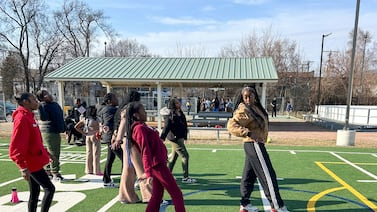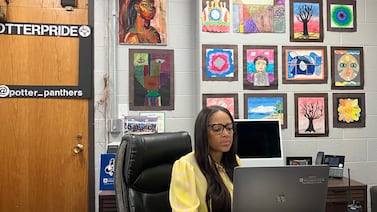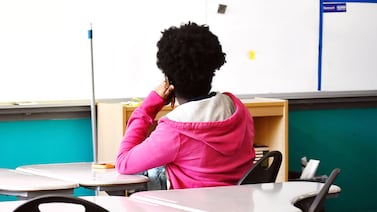Sign up for Chalkbeat Chicago’s free daily newsletter to keep up with the latest education news.
Fourth and fifth grade teacher Rachael Mahmood wants to ensure all her students feel like they belong. That’s why she works hard to incorporate their identities, cultures, interests, and histories into her lesson plans and assignments.
Mahmood, who has taught at Indian Prairie CUSD 204 for the past 19 years, was recently named the Illinois Teacher of the Year for 2024. The Illinois State Board of Education, which gave out the award, said in a press release that Mahmood has “a passion for designing curriculum that affirms students’ identities” and fosters their love of school. That has been a mission for her ever since she was a young student. (Indian Prairie CUSD 204 serves students in some of Chicago’s southwest suburbs.)
Growing up in Downers Grove, a predominately white suburb west of Chicago, Mahmood was often one of the few students of color in the classroom. She spent her early years feeling like an outsider. Now, she has curated a classroom where students know that they are welcome and are a part of a community.
Mahmood said she was shocked and pleasantly surprised to learn she had been named Teacher of the Year. In an interview with Chalkbeat Chicago, Mahmood said that these awards and recognitions remind educators that they are doing good work in the classroom.
“You have to be intentional in telling people that they belong and recognizing the contributions they can share in a classroom, to your school, and to the greater good of children,” she said.
Chalkbeat Chicago spoke to Mahmood about why she became a teacher (despite pressure to go to medical school), her favorite lesson to teach, and the lengths she goes to make all her students feel a sense of belonging.
This interview has been lightly edited for length and clarity.
What were your experiences like at school?
My mom is a Russian Jew and my dad’s an Indian Hindu. I grew up in Downers Grove and I was one of very few minority students in my classroom — sometimes the only student of color in my class and the only non-Christian student. As I was growing up, I never saw representations of myself in the curriculum or teachers. We didn’t celebrate holidays or the contributions of my culture to American history. I really struggled with issues of belonging in school and feeling like I was normal.
You had a very isolating experience as a student, why did you want to be a teacher?
I liked to go to school. I liked to learn. I was good at school. I knew I wanted to be a teacher. My dad told me that if I became a doctor — both my parents were physicians — that he would buy me a brand-new car. I was so adamant to become a teacher, and I would always tell him. He said one day, “If you become a teacher, I’ll buy you a bicycle.” I still went into education.
When did you figure out what kind of teacher you wanted to be for your students?
I remember sitting in my college class and learning about multicultural education. It is a pedagogy that’s been around since the 1960s, and it’s all about affirming students’ cultures and identities in the classroom. I was thinking, “Why didn’t I have teachers who did this for me?” If I would have felt like I was normal and that I belonged growing up, that would have changed my whole upbringing as a student and my sense of identity as a young person. I vowed to be the teacher who normalizes diversity.
As a teacher for almost 20 years, how do you affirm your students’ culture and their identities?
First, I observe my students. I learn about their cultural backgrounds and what interests them. Then I try to create lessons that bring all of that in. For example, I have Filipino, Mexican, and Pakistani students in my class, so when I give a lesson on the Civil Rights Era in America, I talk about civil rights in terms of those cultures, [too]. Next, I’ll bring in students’ interests and talents into the classroom. I let students show what they know about graphic design through posters. I have students that are very tech-savvy, so I’ll ask them to design movies or slideshows.
What’s your favorite lesson to teach and why?
I like teaching things that are relevant now, so it changes every year. This year, my students read this book called “Inside Out and Back Again” [by Thanhhà Lai], which is about a Vietnamese girl who comes to America as a refugee during the Vietnam War.
During class, we talked about the Vietnam War … and about the experiences of refugees. For an assignment, my students were asked to pack their bags as if they were leaving home tonight and they brought them to school and gave mini speeches on what they brought. I had a dad who was a Vietnamese refugee come and speak to the kids.
How do you approach news events in your classroom?
Personally, I just let the kids lead. The kids come in, and they have a lot of questions about the world around them all the time. I don’t have to be the person who has information, but I can help them find information and have meaningful discussions.
What’s the best advice you’ve ever received, and how have you put it into practice?
The best advice I have gotten is “whatever you focus on expands.” If you focus on looking for the negative in your students, with your colleagues, and about your administration and policies, you will find plenty of that. But if you choose to focus on the positives, see the gifts your kids bring to school, see the talents of your colleagues, and see the strength of your administrators, you will also find plenty of that. It doesn’t mean that there aren’t things that we need to fix in education, but we can come at those things with an asset-based lens. Plus, focusing on the positive will make you happier.
What’s one thing you’ve read that has made you a better educator?
I think the first book I read that made me kind of see the type of teacher I wanted to be was “Dream Keepers’' by Gloria Ladson-Billings. It was portraits of teachers who are culturally responsive and how they act in the class in a way that supports students. I remember reading the book and being like, ‘Oh my gosh, those teachers seem so much like me.’
Samantha Smylie is the state education reporter for Chalkbeat Chicago, covering school districts across the state, legislation, special education, and the state board of education. Contact Samantha at ssmylie@chalkbeat.org.








